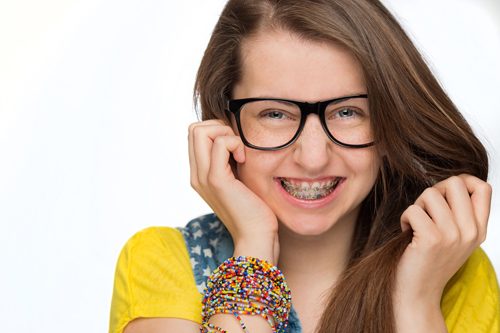In the past, pop culture used glasses and braces as shorthand for ‘nerds’. The idea was that kids like that were bookish and uncool, even though in reality, they simply had flawed teeth or diminished eyesight (and parents with the resources to fix both). Unfortunately, people often believe what they see on TV more than what they see in the world outside. Sad but true.

These stereotypes were reinforced by the fact that few of the ‘cool’ adults wear braces or glasses in social settings. When they go out, they switch to contacts or sunglasses. As for braces, most people got rid of their ‘railway lines’ in their late teens.
These days, technology has made things easier in some ways. For example, more adults are embracing their braces. They are in a better position to pay for dental care and being older and wiser; they can recognise that the results outweigh the hassle. In certain demographics, adult braces have almost become a status symbol.
It’s not certain whether adult braces are a fad or a shift in attitudes towards oral health, but seeing adults in braces is certainly likely to reduce your child’s objections to braces. The more they see it, the more normal it will seem, and the less likely they are to refuse.
But why do patients need braces in the first place? Well, wearing braces for a few years can correct dental flaws like crowded or crooked teeth, overbites, or underbites. They can also repair a misaligned jaw or help injured jaw bones to heal.
Braces are most effective in teens and young adults since their jaws and permanent teeth are still growing, so they can be moulded more easily. If your child refuses braces, find out why they’re so against it. Try to get specific reasons, so that you can tackle them more effectively.
Most kids don’t want braces because they think their friends will make fun of them, or that they will look nerdy and uncool. Your first reflex as a parent is to either force them or reason with them. Both approaches can be difficult since force only makes them more stubborn, and teenagers aren’t always known for sound logic.
Rather than convincing your teens that braces are a good idea, lay out some objective benefits so that with time, the kids will see the light for themselves. Since teens are always on their screens and smartphones, use it against them. A quick online search will give you graphic before-and-after photos of celebrities that once wore braces.
Share these with your child for a triple benefit. It viscerally proves what an amazing aesthetic (and medicinal) change braces can make. It shows them some very cool people that had braces in the past. And it gives them a weapon to use against teasing. They can confidently say, ‘Guess who else wore braces! They’re pretty cool, so I guess I am too.’
Kids might still worry about their braces looking weird or being painful. Braces rarely hurt, and if they do, it’s short-lived. And modern braces can be colour-coded to match your teen’s style. Of course, you could compromise and get them invisible braces. They fix teeth in a far shorter time than conventional braces, and they’re not visible when they’re worn.

Invisalign can take as little as half the duration of traditional braces, and since you get a new fitted set every two weeks, there’s no tooth fatigue. Since teens view time quite differently from adults, it’ll be easier for them to think about their braces in two-week increments, as opposed to the standard two-year braces which seem like ‘for.e.verrrr!’
Invisalign offers lots of advantages to socially insecure teens. They are customised and fitted to each patient, matching the shape of their mouth, teeth, jaws, and tongue. This means they sit flush in the mouth and will not affect the way you talk. No orthodontic lisping here.
They’re also easier to maintain, since your teens can remove them when they need to eat, brush, or floss, so it’s a lot less work. Plus, if your teens were worried about the awkward care routine of cleaning their teeth at school or avoiding ‘fun’ (junk) foods while out with friends, they will love discreet aligners that can be slipped on and off with no discernible difference.
The only downside of Invisalign is that they don’t work on milk teeth, so if your child hasn’t erupted all their teeth yet, make a deal. Offer them a ‘stay of execution’ on the condition that once all their teeth are in, they will agree to invisible braces. This way, everyone is happy.
Information is collected from http://bit.ly/2fvowaS
Image source: es.123rf.com and pixabay.com
